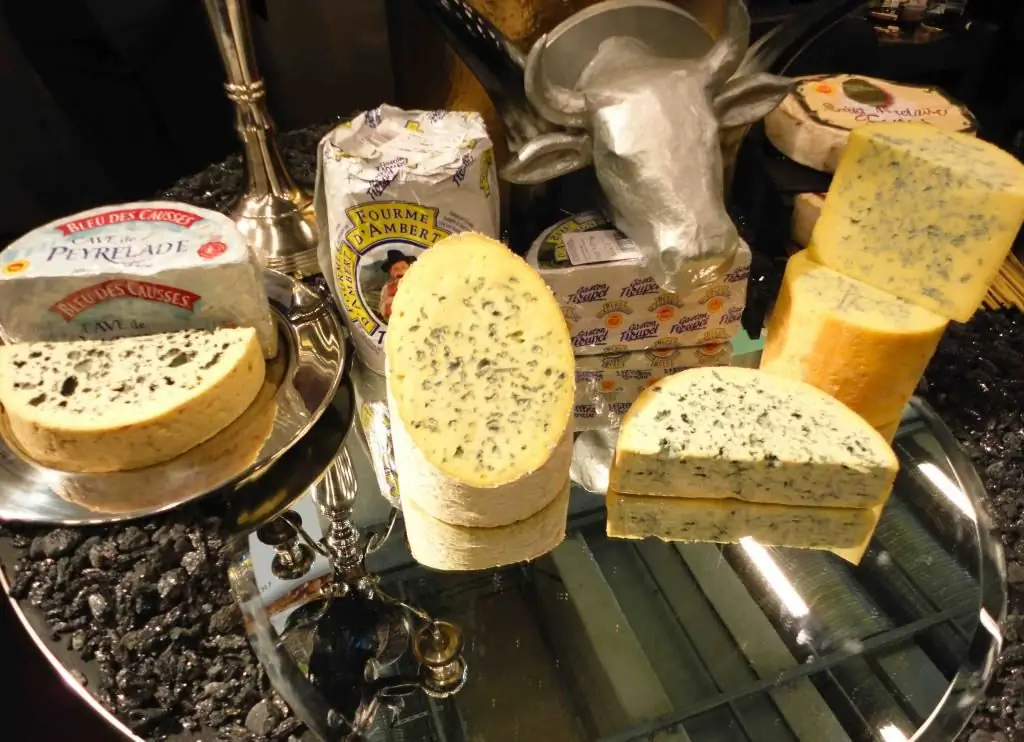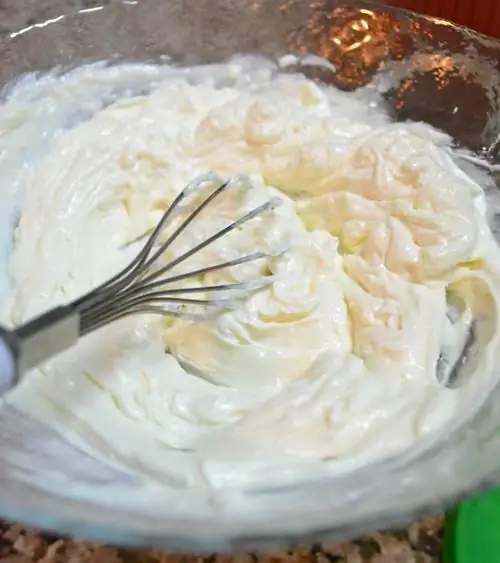2025 Author: Isabella Gilson | [email protected]. Last modified: 2025-01-23 12:50:33
Roquefort cheese is the king among the noble blue cheeses with mold. Initially, this variety began to be produced in France, south of the central regions, in the province of Rouergue. Connoisseurs say that Roquefort is more than a thousand years old, and its birth is associated with a beautiful legend. According to it, one day a young man grazing sheep on a mountainside decided to have a bite of cheese and bread in a damp cave, where it smelled of mold. But when he saw a beautiful girl, he immediately ran after her, forgetting about dinner. Only a few weeks later the shepherd remembered the failed meal, returned to the cave and saw that the piece of cheese was all moldy. But he was so hungry that he dared to eat such a dubious product and was delighted with its amazing taste.
Most likely, this is just a beautiful fairy tale, but the technology of maturing cheese with mold in limestone grottoes was invented in the south of France.

From what milk is Roquefort cheese made
The province of Rouergue has long been famous forits sheep, which are still today considered one of the best breeds in the world. Therefore, asking what kind of milk Roquefort cheese is made from is somewhat inappropriate. Of course, from sheep. It is the amazing creamy taste of sheep's cheese, combined with a sharp aroma and pungent aftertaste of noble mold, that gives birth to real Roquefort.

However, over time, the famous product began to be made outside of France. And cow's milk appeared in the recipe in symbiosis with the original fungal cultures. This is not to say that such cheese is bad - it fully complies with the most stringent standards and has a recognizable taste and aroma of the original Roquefort. But connoisseurs notice the difference.
Production
Noble cheese is made from high-quality raw or pasteurized (in some countries it is forbidden to make cheese from raw) milk. Initially, the raw material is heated to +24 ⁰С, after which the starter is added - cultures of lactic acid bacteria. Under their influence, the coagulation of milk begins and a clot is formed. The process takes place at a temperature of +30 ⁰С.

The resulting clot is cut into pieces of 1x1 cm - a cheese grain is obtained. It is kneaded and left for an hour to allow excess whey to drain. Dried grain is crushed in special crushers, laid out in forms, and each layer is sprinkled with Penicillium Roquefort. The thickness of each layer is 2.5 cm. The molds are kept at a temperature of +20 ⁰С for three days. Then the cheese is released from the mold and s alted - drymethod or soaking in brine.
The next step in production is ripening. The head is pierced with a special apparatus with needles - the holes will provide comfortable conditions for the development of mold. Next, the cheese is placed in comfortable conditions for ripening (high humidity and low temperature) and left for 2 months, wiping off excess mucus once a day.
Cheese caves
In France, the cheese matures in natural caves, where this famous delicacy was born. Lime grottoes have an ideal microclimate for the maturation of heads. It is interesting that tourists are allowed here: here, inquisitive gourmets will be told the recipe for Roquefort cheese and will be allowed to taste the product. The entrance fee is 5 euros for an adult and 3 euros for a child. The best time to visit is from October to March.

Currently, 7 factories are engaged in the production of Roquefort cheese - it is on them, according to connoisseurs and connoisseurs, that the real royal cheese is made. These companies provide 70% of the demand for this delicacy around the world. The remaining 30% comes from other cheese factories around the world.
Nutritional value
Cheese is a high-calorie, fatty food, and Roquefort is no exception. It contains 353 kcal per 100 g of product. Therefore, its consumption should be limited to overweight people. At the same time, Roquefort is considered one of the most useful varieties: it contains a large amount of protein (so it can compete with meat products), vitamins A, B, C, D, E, H, saturated fattyacids, trace elements (especially a lot of calcium) and amino acids valuable for our body.
Useful properties of Roquefort
If you remember what kind of milk Roquefort cheese is made from, it immediately becomes clear why it is so useful. Sheep milk is a valuable and he althy product, it is 1.5 times more nutritious than cow's milk and contains many useful substances. And the casein contained in it allows people with an allergy to cow's milk to use this product.

If sheep's milk is flavored with the noble mold Penicillium Roquefort, you get a superfood with a lot of useful qualities:
- Roquefort has an anti-inflammatory effect.
- The high nutritional value makes you feel full quickly, and a person who regularly eats blue cheese becomes less prone to overeating.
- Beneficial fungi increase the production of melanin, which protects the skin from harmful ultraviolet radiation.
- It is believed that this product slows down the aging process. Some French people cite eating blue cheese as the reason for their excellent he alth and longevity.
- Roquefort blue cheese reduces the risk of heart attacks and strokes, as noble fungi thin the blood and prevent the formation of clots.
- It is a supplier of calcium to the body, helps to strengthen bone tissue. The delicacy is recommended for people with fractures and women during menopause.
- Contains easily digestible protein.
The harm of cheese withmoldy
Now for a little fly in the ointment. A noble product is recommended to use regularly, but in small portions. A safe dose for a he althy person is 50 g of the delicacy per day. If you abuse and constantly exceed the norm, the process of inhibition of your own intestinal microflora by third-party microorganisms is possible.
Also, listeria is found in Roquefort, which can lead to an infectious disease. A he althy person does not even notice the infection, as his immunity quickly cracks down on foreign agents. But the sick, as well as people with poor he alth, should be more careful. Listeriosis is especially dangerous for pregnant women.
Roquefort should also not be consumed by those who have allergic reactions to penicillin and dairy products.

How to choose
- The first criterion is composition. Everyone probably knows what Roquefort cheese looks like. What kind of milk it is made from was also discussed. If you need to please some sophisticated gourmet, you need to choose a product made from sheep's milk, and not from cow's milk. What else to look out for?
- Next, look at the appearance: Roquefort is white on the cut, its surface is oily and covered with veins with mold. The structure of this delicacy is very delicate (it is cut with a special string knife), but it should not crumble or fall apart.
- A lot of mold indicates that the product is overexposed. The mold in blue cheese is alive, it eats the white mass all the time. So if Roquefort is kept too long, thenfungus can "eat" most of the head.
- Real Roquefort has a red sheep stamp on the label.
- Smell. This delicacy has a sharp pronounced aroma, characteristic of sheep's milk.

With what to eat and how to store noble cheese
Roquefort is a variety with live cultures that constantly "eat" the product. The main task is to slow down their growth, therefore, the cheese should be stored at a temperature not higher than +6 ⁰С. It is impossible to freeze the delicacy - so it will noticeably lose both in taste and nutritional value. Optimum humidity is 95%.
Product should be stored in foil or parchment packaging to prevent the fungus from spreading to other foods. You should not put Roquefort with strong-smelling food - smoked meats, fish, onions, etc., as the tender mass absorbs all smells like a sponge.
Blue cheese is an expensive delicacy. For 1 kg you will have to pay 1300-1500 rubles. Therefore, Roquefort is most often served on a separate dish as an independent delicacy or as a component on a cheese plate at the end of a meal with other noble cheeses.
It is also eaten with fruits (pears, grapes) or wines: dry white or fortified. Roquefort should be at room temperature when served - only in this way will the delicacy fully reveal its delicious creamy taste and give a wonderful aftertaste. And gourmets advise trying a piece of royal cheese with a drop of honey - this combination will delight all taste buds.
Recommended:
How blue cheese is made: ingredients and recipes. Blue cheese: benefits and harms

Blue cheese is a world-famous delicacy that has been enjoyed by many gourmets. There are a lot of varieties and types: camembert, dor blue, livaro and many others. The recipe for making such a product is quite ancient: cheeses with mold have been made for four thousand years. Mentions of them can be found even in Homer and Aristotle
Interesting facts about milk. Milk can turn sour during a thunderstorm. Frog in milk. Invisible milk ink

From childhood, everyone knows that milk is an extremely he althy product. In ancient times, it was even considered a cure for many diseases. Why does milk turn sour during a thunderstorm. Why do you need to put a frog in it. Which animal has the fattest milk? Why adults shouldn't drink it. We bring to your attention the most interesting facts about milk
What rolls are made with: filling recipes and cooking technology

Sushi and rolls are one of the favorite dishes not only in Japan, but all over the world. If you rarely manage to enjoy this product in a sushi bar, but you want to please your family, you can cook it yourself. What are rolls made with and how to cook them according to all the rules? In the article there are all possible options for fillings and tips from the masters
How tea is made: an overview of methods, a description of technology and recommendations

Are you a fan of delicious and fragrant tea? Then this article is for you! Today we will talk about how to collect, dry and make tea of various varieties. Let's get acquainted with the traditions of different countries and tell you the secrets of making this tasty and he althy drink
Mastic from condensed milk. Milk mastic on condensed milk. Mastic with condensed milk - recipe

You can, of course, go to the store and buy ready-made cake decorations from marshmallows, glucose and glycerin. But, firstly, all these garlands, beads and bows with flowers do not bear a trace of your individuality and creative imagination, and secondly, they are not cheap. Therefore, today we will learn how to make mastic from condensed milk

